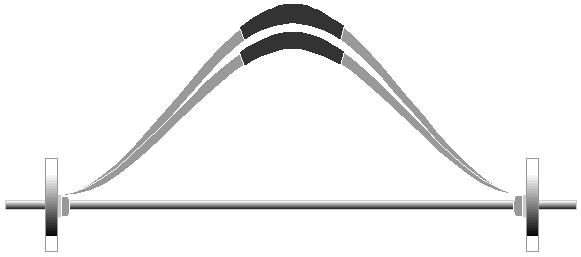Click Here To For Your FREE Muscle Building Magazine Subscription
Make Your Own Belt Squat Straps

By Wesley James
https://www.pipeline.com/~wjames/MuscleMaker/
This is more an assembly project than a real construction. The toughest part of the project will be tracking down the necessary parts. Fortunately, there aren't too many. The major components, of course, are the straps themselves. Since you'll probably want to be able to squat heavy at times, you'll want strong strapping material. The strongest we've found is made for climbing. It comes in different widths, weights and thicknesses. We suggest you use the strongest you can find- better safe than sorry. It is also better to have more than you'll need, so you should probably buy a length four times your height. You won't need quite that much but this will insure you have enough. While you're at the store, you'll also want to buy the padded shoulder straps, though you can make them. The ones we prefer are made for use with back packs. In this design, they surround the weight-bearing straps but do not support any weight themselves. They slide freely along the straps so that they can be adjusted as necessary.
The rings used at each end of each strap are a type of Carriage Ring. We obtained them from a riding (horse-back) equipment supplier. There may be other sources. The length adjustment buckles should also be available from these suppliers. The stitching that holds the buckles on the straps at each end are best sewn with the strongest thread you can obtain. We've found the thread used for sewing sails is best. Very heavy carpet thread or heavy monofilament fishing line also work. You'll also need large, strong needles, Upholsterer's Needles are ideal. You'll also need a pair of needle-nose pliers for the sewing and probably a metal thimble. We don't advise using gromets or rivets. Both have a tendency to rip through the web material of the straps over time.
The construction of the buckles is shown in the illustration at right. This design is common to buckles made for clothing as well. Some of these clothing buckles are even made of metal. Such buckles are not, however, intended for use in weight-bearing applications. You must obtain buckles made for climbing or back-packing or they may fail at the worst possible time. This can be dangerous.
When choosing the straps, be aware that they must work with the rings and buckles you have available. If the buckles are too large for the straps, they may slip under load. It is best to purchase the rings and buckles first and test them in this configuration before purchasing lengths of the strap material.
The trickiest part of using these, or any other, squat straps is making absolutely certain that both straps are precisely the same length. Fortunately, this adjustment need not be made often. The easiest way to make re-adjustments easier, as might be required when training partners are of radically different heights, is to stitch a line of thread across the belt to mark at the correct lengths. You can use different thread colors for each user. Generally, the bar should be at or above knee level.
In use, you straddle the bar and squat. You then position the pads over the shoulders, just inside the point where the deltoids meet the traps. You should always make certain your knees are directly over our toes then begin your set.
You will find these Squat Straps a great deal easier on the shoulders than a bar. Moreover, they are the only way to squat safely without expensive machines. Enjoy.
Copyright © 1996 Physique Tools and Wesley James
Editors note: Why pay costly health club memberships when you can get a total body workout in your home? You will save save hundreds building your own Home Multi Gym equipment from common materials. This is the best collection of design blueprints for building your own weight training equipment. ...Home Gym Plans How To Build A Home Gym Inexpensive Home Gym Designs
Anabolic Bodybuilding Supplements
Muscle Mass Magazine | Store | Articles | Tips | Exercises | Terms | Reviews | Links | Contact
Click Here To For Your FREE Muscle Building Magazine Subscription
Disclaimer: The information presented is intended to be used for educational purposes only. The statements made have not been evaluated by the Food and Drug Administration (U.S.). This product is not intended to diagnose, treat, cure or prevent any condition or disease. Please consult with your own physician or health care practitioner regarding any suggestions and recommendations made.

